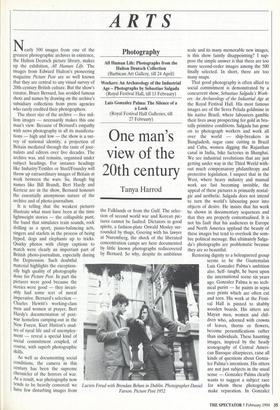ARTS
Photography
All Human Life: Photographs from the Hutton Deutsch Collection (Barbican Art Gallery, till 24 April)
Workers: An Archaeology of the Industrial Age – Photographs by Sebastiao Salgada (Royal Festival Hall, till 13 February)
One man's view of the 20th century
Tanya Harrod
N
early 500 images from one of the greatest photographic archives in existence, the Hulton Deutsch picture library, makes up the exhibition, All Human Life. The images from Edgard Hulton's pioneering magazine Picture Post are so well known that they are central to any visual survey of 20th-century British culture. But the show's curator, Bruce Bernard, has avoided famous shots and names by drawing on the archive's subsidiary collections from press agencies who rarely credited their photographers.
The sheer size of the archive — five mil- lion images — necessarily makes this one man's view. Because of Bernard's empathy with news photography in all its manifesta- tions — high and low — the show is a sur- vey of national identity, a projection of Britain mediated through the taste of jour- nalists and editors over five decades. The archive was, and remains, organised under subject headings. For instance headings like Industry/Textiles or Steel/Foundry will throw up extraordinary images of Britain at work between the wars. So, though big names like Bill Brandt, Bert Hardy and Kertesz are in the show, Bernard honours the essentially anonymous nature of the archive and of photo-journalism.
It is telling that the weakest pictures illustrate what must have been at the time lightweight stories — the collapsible punt, the band that simulates train sounds, rock drilling as a sport, piano-balancing acts, singers and starlets in the process of being hyped, dogs and elephants up to tricks. Quirky photos with chirpy captions to match were clearly an important part of British photo-journalism, especially during the Depression. Such doubtful material highlights the exception- ally high quality of photography done for Picture Post. In part the pictures were good because the stories were good — they invari- ably had some sort of moral Imperative. Bernard's selection Charles Hewitt's working-class men and women at prayer, Bert Hardy's documentation of post- war homeless camping-out in the New Forest, Kurt Hutton's stud- ies of rural life and of unemploy- ment — reveal a special kind of social commitment coupled, of course, with superb photographic skills.
As well as documenting social conditions, the camera in this century has been the supreme chronicler of the horrors of war. As a result, war photography now tends to be heavily censored: we have few disturbing images from
the Falklands or from the Gulf. The selec- tion of second world war and Korean pic- tures cannot be faulted. Dictators in good spirits, a fashion-plate Oswald Mosley sur- rounded by thugs, Goering with his lawyer at Nuremberg, the shock of the liberated concentration camps are here documented by little known photographs rediscovered by Bernard. So why, despite its ambitious Lucien Freud with Brendan Behan in Dublin. Photographer Daniel Farson. Picture Post 1952 scale and its many memorable new images, is this show faintly disappointing? I sup- pose the simple answer is that there are too many second-order images among the 500 finally selected. In short, there are too many snaps.
That good photography is often allied to social commitment is demonstrated by a concurrent show, Sebastiao Salgada's Work- ers: An Archaeology of the Industrial Age at the Royal Festival Hall. His most famous images are of the Serra Pelada goldmine in his native Brazil, where labourers gamble their lives away prospecting for gold in bru- tally primitive conditions. Salgada has gone on to photograph workers and work all over the world — ship-breakers in Bangladesh, sugar cane cutting in Brazil and Cuba, women digging the Rajasthan canal in India, bike factories in Shanghai. We see industrial revolutions that are just getting under way in the Third World with- out much compensatory philanthropy and protective legislation. I suspect that in the West, where heavy industry and manual work are fast becoming invisible, the appeal of these pictures is primarily nostal- gic and aesthetic. Salgada does not intend to turn the world's labouring poor into objects of desire. He insists that his work be shown in documentary sequences and that they are properly contextualised. It is not his fault that his audiences in Europe and North America applaud the beauty of these images but tend to overlook the som- bre political message. But ultimately Salga- da's photographs are problematic because they are so beautiful.
Restoring dignity to a beleaguered group seems to be the Guatemalan Luis Gonzalez Palma's ambition also. Self- taught, he burst upon the international scene six years ago. Gonzalez Palma is no tech- nical purist — he paints in sepia over prints which are often cut and torn. His work at the Festi- val Hall is pinned to shabby wooden boards. His sitters are Mayan men, women and chil- dren who, adorned with crowns of leaves, thorns or flowers, become personifications rather than individuals. These haunting images, inspired by the heady iconography of Central Ameri- can Baroque altarpieces, raise all kinds of questions about Gonza- lez Palma's intentions. His sitters are not just subjects in the usual
sense — Gonzalez Palma clearly wants to suggest a subject race for whom these photographs make reparation. In Gonzalez
Palma the Indian population of Guatemala appears to have found a champion even if some of his work is so heavily romantic that it suggests stasis rather than any possibility of change. His weakest images are often the most seductive, the creations of a youthful dreamer with a dressing-up box. But the finest pictures — America and King for instance — are political state- ments in the subtlest sense, teaching us obliquely more about Guatemala's trou- bled history than any collection of facts and figures.



















































 Previous page
Previous page